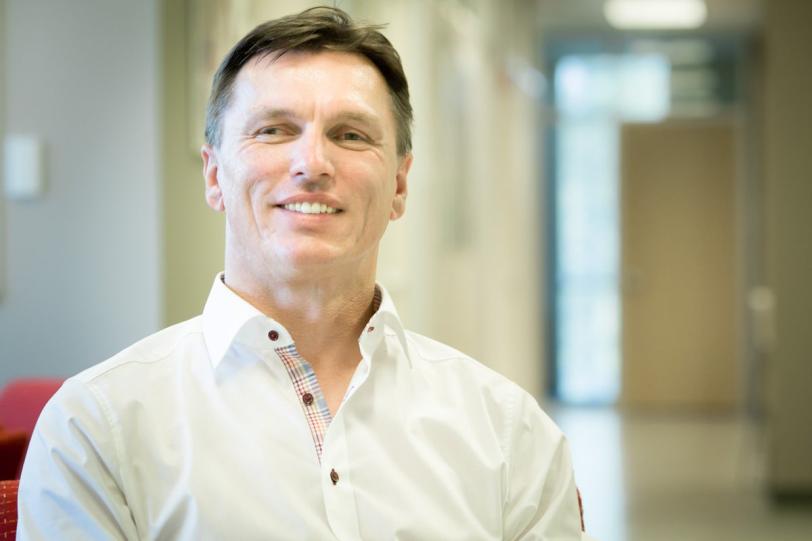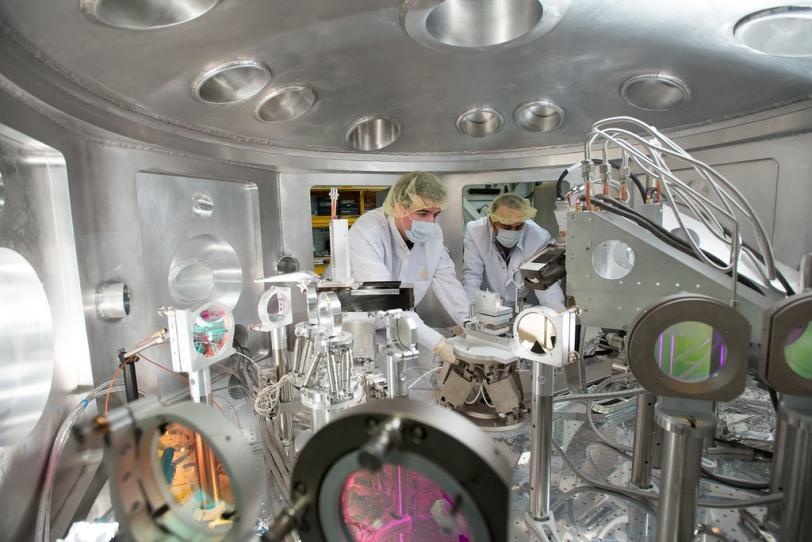SLAC's Siegfried Glenzer Selected to Receive E.O. Lawrence Award
SLAC's Siegfried Glenzer has been selected to receive an Ernest Orlando Lawrence Award, presented by the U.S. Secretary of Energy to honor scientists across a range of fields.
By Glenn Roberts Jr.
Siegfried Glenzer, a distinguished staff scientist at SLAC who specializes in high-power laser experiments of matter in extreme conditions, has been selected to receive an Ernest Orlando Lawrence Award, presented by the U.S. Secretary of Energy to honor scientists across a range of fields.
The award, announced today, recognizes his pioneering work to develop and apply a technique known as X-ray Thomson scattering to precisely measure the temperature and other properties of dense plasmas.
"This award is a great honor – not only to me, but to all the scientists with whom I was privileged to collaborate on our great endeavor to understand nature," Glenzer said.
Glenzer is a part of the Stanford Institute for Materials and Energy Sciences, a joint institute of SLAC and Stanford, and a frequent participant in experiments conducted using the Matter in Extreme Conditions (MEC) experimental station at SLAC's Linac Coherent Light Source (LCLS) X-ray laser.
'Father' of X-ray Thomson scattering
He joined SLAC last year from Lawrence Livermore National Laboratory, where he worked from 1995 to 2013. He led the plasma physics group at Livermore Lab's National Ignition Facility (NIF), where scientists are pursuing self-sustaining laser-driven fusion reactions as a possible future energy source.
Much of Glenzer's research using the X-ray Thomson scattering technique was performed as a scientist at Livermore Lab, using high-power lasers there and at other labs. X-ray Thomson scattering experiments are useful for fusion research, Glenzer said, as well as to simulate the conditions in dense planets and conduct fundamental science research. The technique could also be used to study new materials formed in compressed-matter experiments.
Such explorations are marrying many scientific disciplines, including cosmology and material sciences, he said. "Now it's all coming together. We are pushing the envelope, doing discovery-class science."
"Siegfried is the 'father' of X-ray Thomson scattering," Philip Heimann, who oversees the team of scientists at the MEC experimental station at SLAC's LCLS, said. "The technique has proved to be an important probe of electron temperature and electron density in plasmas. It is one of the main diagnostics used at MEC."
Five other scientists to receive awards
Five other scientists at Department of Energy laboratories have also been named recipients in this latest round of E.O. Lawrence honors, which have been awarded since 1960. They will formally receive their awards in a ceremony later this year in Washington, D.C., and include:
- Adam Arkin of Lawrence Berkeley National Laboratory, for work in biological and environmental sciences
- John C. Wagner of Oak Ridge National Laboratory, for work in computer, information and knowledge sciences
- John L. Sarrao of Los Alamos National Laboratory, for work in condensed matter and materials sciences
- Margaret S. Wooldridge of the University of Michigan, for work in energy science and innovation
- Steven C. Myers, Livermore Lab, for work in national security and nonproliferation
"The Lawrence Award recipients announced today have made significant contributions to the national, economic and energy security of the United States – strengthening U.S. leadership in discovery and innovation," said Energy Secretary Ernest Moniz. "I congratulate the winners and thank them for their work on behalf of the Department of Energy and the nation."
The award was established in memory of Lawrence, who received the 1939 Nobel Prize in Physics for inventing the cyclotron, which was used to accelerate subatomic particles and create new forms of radioactive elements. Lawrence died in 1958.
It recognizes mid-career scientists and engineers for "exceptional scientific, technical, and/or engineering achievements related to the broad missions of the U.S. Department of Energy and its programs." The award includes a certificate, medal bearing Lawrence's likeness, and a $20,000 honorarium.
Past SLAC recipients
Glenzer is the latest in a series of SLAC recipients of the award. This list includes:
- Wolfgang K. H. "Pief" Panofsky (1961)
- Sidney D. Drell (1972)
- Burton Richter (1975)
- Kaye D. Lathrop (1976)
- James D. Bjorken (1977)
- Keith Hodgson (2002)
- Zhi-Xun Shen (2009)
SLAC is a multi-program laboratory exploring frontier questions in photon science, astrophysics, particle physics and accelerator research. Located in Menlo Park, California, SLAC is operated by Stanford University for the U.S. Department of Energy Office of Science.
SLAC’s LCLS is the world’s most powerful X-ray free-electron laser. A DOE Office of Science national user facility, its highly focused beam shines a billion times brighter than previous X-ray sources to shed light on fundamental processes of chemistry, materials and energy science, technology and life itself. For more information, visit lcls.slac.stanford.edu.
DOE’s Office of Science is the single largest supporter of basic research in the physical sciences in the United States, and is working to address some of the most pressing challenges of our time. For more information, please visit science.energy.gov.







